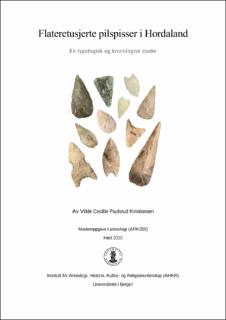Flateretusjerte pilspisser i Hordaland: En typologisk og kronologisk studie
Master thesis
Permanent lenke
https://hdl.handle.net/11250/2722661Utgivelsesdato
2020-12-11Metadata
Vis full innførselSammendrag
The purpose of this study is to analyse the bifacial arrowheads found in Hordaland county in Western Norway to see if there is any morphological and chronological variation in the material. A typological method was applied to analyse the morphology of the arrowheads and previous chronological studies, as well as datings of the material in the survey area, was used to analyse the chronology of the arrowheads. The bifacial arrowheads are introduced in the research area at the beginning of the Late Neolithic, ca. 2350 BC. From this time on, the bifacial technology replaces already existing lithic traditions in the area. The technology seems to be in use over a long period of time, all the way into the Pre-Roman Iron Age and possibly into the early Roman Age. The result of the study shows that the morphology of the arrowheads goes through several changes within this time period. It also demonstrates a continued use of hunting in a growing agricultural society. An analysis of the distribution pattern of the arrowheads also shows that in the early Late Neolithic they are concentrated in the coastal area in the southern part of the research area, possibly connected to Bell Beaker migrations from Jutland to Southwest-Norway. Later during this period the distribution seems to change, and through the Bronze Age and into the Pre-Roman Iron Age they are primarily in use in the middle and northern coastal parts and in highland areas to the east and southeast in Hordaland.
